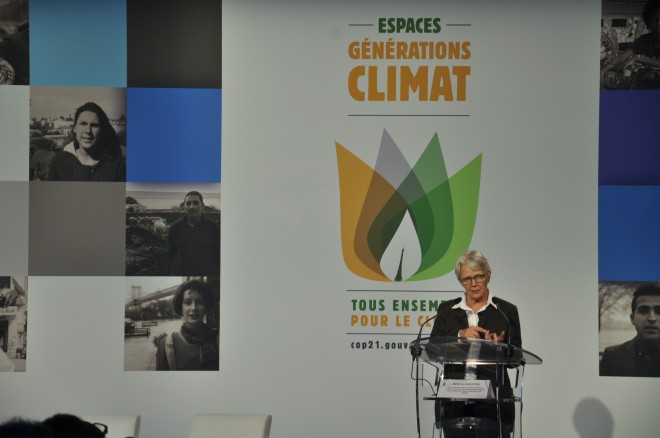
Margareta Wahlstrom, head of the UN Office for Disaster Risk Reduction, gives a keynote address at a forum on assessing disaster risk reduction on Dec. 9, 2015, in Paris, France. The forum is one of many side events held in conjunction with the 21st Conference of Parties. PHOTO BY SARA PACIA/INQUIRER.NET
PARIS – Amid debates on mitigation and climate finance at the 21st Conference of Parties (COP21), the United Nations Office for Disaster Risk Reduction said parties should not forget the importance of referencing disaster risk reduction (DRR) as part of the climate change agenda.
Margareta Wahlstrom, special representative of the United Nations (UN) Secretary-General for disaster risk reduction, said two hours before the latest clean text was released that DRR, specifically the new Sendai Framework for Disaster Risk Reduction, should be highlighted as a way of strengthening vulnerable countries’ resilience to climate change.
“I think it’s important that the climate agreement recognizes along with the SDGs (Sustainable Development Goals) also the Sendai agreement, and that includes risk and mentioning disaster risk as something that is important,” Wahlstrom told INQUIRER.net on the sidelines of a forum on the role of insurance companies in analyzing and combating risk.
The latest draft of the Paris agreement was released at 3 p.m. Paris time (10 p.m. Philippine time) on Dec. 9, 2015. No clear mention of DRR was included, the closest wording being under the bracketed “loss and damages” section, wherein those who will sign the agreement are encouraged “to strengthen and, where appropriate, develop early warning systems and risk management plans for both extreme events and slow onset events.”
READ: Draft Paris climate compact now down to just 14 pages
However, Wahlstrom, who also heads the UN Office for Disaster Risk Reduction (UNISDR), was well aware of the nuances of creating a legally binding agreement to reduce carbon emissions that 195 countries, or parties, would subscribe to until 2050.
“The most important thing now is to get an agreement to be as complete as possible. In the process, unfortunately, they will make compromises,” she said.
“But I hope this (DRR reference) will not be one,” she quickly added.
COP21, slated to conclude on Dec. 11, 2015, aims to ink an agreement among legally binding parties to cap the global temperature rise to either under 1.5 degrees or under 2 degrees Celsius below preindustrial levels.
BACKSTORY: PH: Where is adaptation finance in climate pact?
Sendai Framework
The Sendai Framework is a 15-year nonbinding agreement meant to reduce existing risks due to climate change by 2030. It was adopted last March 18, 2015, at the 3rd World Conference on Disaster Risk Reduction held in Sendai, Japan.
Seven global targets, among them to increase the number of countries with national and local DRR strategies and make easily available multihazard early warning systems, make up the backbone of the framework, along with four priorities for action:
- Understand disaster risk;
- Strength disaster risk governance to manage disaster risk;
- Invest in disaster risk reduction for resilience, and
- Enhance disaster preparedness for effective response and to “Build Back Better” in recovery, rehabilitation and reconstruction.
The framework is also one of three road maps the Philippines will follow in strengthening existing–and institutionalizing new–mitigation and adaptation policies. The other two are the 17 Sustainable Development Goals, adopted last Sept. 25, and the outcome of the final agreement from COP21.
According to the UN report “The Human Cost of Weather-related Disasters,” released a week before COP21, the Philippines had the fourth highest number of disasters (274) from 1995 to 2015. RAM
RELATED STORIES
BACKSTORY: Real disaster risk reduction challenge in PH is at local level
PINAS TO PARIS Part 2: Zero, saving lives